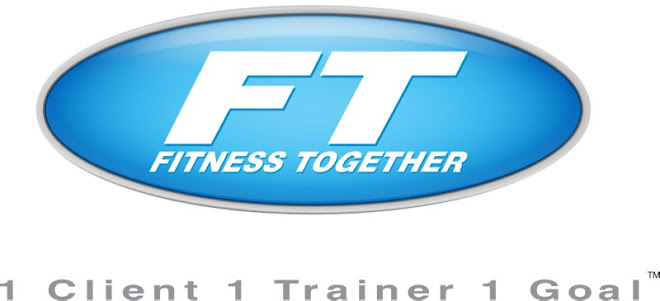"You can change your fate simply by eating well!"
1 Client. 1 Trainer. 1 Goal.
Tuesday, September 29, 2009
10 Steps to Heart Health
"You can change your fate simply by eating well!"
Tuesday, September 22, 2009
How To Use Your Biggest Fat Burning Muscles—Without Killing Your Knees
It’s no secret that the biggest fat burning muscles in your body are your legs. They are the largest muscles in your body and therefore require the most amount of energy when used. Since your legs are the primary muscles that drive your heart rate up, the more you use them the harder your heart pumps. And the harder your heart works, the more calories you burn and the fitter you get. So if you want to keep up your fitness and fat burning progress, you’d better take care of your legs—especially your knees.
Your knees may arguably be the most important joints in your legs. Without the proper functioning of your knees you’re going to have a real hard time performing effective fat burning exercises, like running intervals. Running can be a great fat burning exercise, but too much running combined with bad biomechanics can lead to overuse—and that mean repetitive stress injuries.
One of the most common knee injuries that people suffer from is the ITB (Iliotibial Band) Syndrome. Your ITB is a long fascial band (tendon) that runs along the entire length of your thigh and attaches your TFL (Tensor Fascia Latae) muscle in your hip to your tibia (shin bone). The function of the TFL via ITB is hip abduction, but perhaps more importantly, it functions to restrict excessive tibial (shin) internal rotation. I know I’m getting a little technical, but I’ll explain.
Your tibia (shin bone) is connected to you ankle bone and your ankle bone is connected to the foot bone and ... well you know how the rest of the song goes. Well, when you take a step walking or running, your foot pronates (arches drop) which causes your ankle and your tibia (shin bone) to internally rotate. This is a normal function of your gait. This happens every time you walk, run or do just about anything that requires you to bear weight on one leg. Problems arise when excessive foot pronation (dropping of your arches) occurs from either poor biomechanics, weak muscles, or from “over doing it”—causing your supporting muscles and tendons to have to work harder than they’re use to.
Too much pronation causes excessive internal rotation of the tibia (shin bone) which puts undue stress on your ITB. Normally your ITB glides over the lateral boney prominence (lateral epicondyle) of your knee every time you bend it, but the increased stress and tension on your ITB increases friction between your ITB and the boney prominence of you knee. If this persists, it can eventually lead to tendonitis, a.k.a ITB Syndrome.
You can, however, easily avoid ITB Syndrome by being a little proactive…
Here is a list of exercises and stretches you can do to avoid ever having to experience such a frustrating injury, so you can make sure to keep your fat burning and fitness progress on track.
(1) Foam Roll (Self Myofascial Release) - Perform this at least once a day. You can do this before and after your workouts. Make sure to roll out your quads, ITB, TFL, and you glutes.
(2) Bowlers Squats - This exercise is a great way to dynamically stretch your TFL and ITB. You can do this as part of you dynamic warm up routine. (Check out the video above to see how it’s done)
(3) ITB Stretch - You probably know by now that I’m not a big fan of static stretching, but this ITB stretch can be quite effective when combined with the previous two exercises. You can incorporate this after your workouts. (Check out the video above to see how it’s done)
(4) Squats and Lunges - Properly performing squats and lunges increases your gluteal strength and can help you minimize the risk of getting injuries like ITB syndrome. The key is proper form—Make sure to learn the how to perform each one of these exercises properly before starting up.
Remember, when it comes to exercising and staying fit, don’t over do it! Listen to your body and don’t push yourself beyond what your body can handle. There’s a very fine line between pushing your limits to improve your fitness and pushing it too much. If you’re starting out, it’s always better to play it on the safe side so that you can continue to make progress without being hindered by injuries.
Written by Shin Ohtake, MaxWorkouts.com.
Edited by Jason Copeland, CSCS
Tuesday, September 15, 2009
The Advantage of a Kettlebell

Like many people who work out, Randy Smith of Atlanta is always pressed for time. That’s why a kettlebell, a type of weight that looks something like a bowling ball with a handle, provides just the workout Smith needs.
"I can get in an intense workout in as little as 20 minutes," says Smith, a 42-year-old banking executive.
How do Smith and thousands of others who have discovered kettlebells do it? Through a unique weight training and cardio workout that comes with swinging and lifting a kettlebell, a type of free weight that ranges from 8 pounds to more than 100.
What makes a kettlebell workout different from other weights workouts?
For starters, you work with only one bell at a time. Hoisting the heavy metal bells not only helps strengthen your arms and pecs, but also works your core, heart and lungs.
"The reason the kettlebell is so great is that there’s offset center of gravity," explains Laura Alton, a certified trainer, physical therapist, and Russian kettlebells certified instructor at the Cooper Fitness Center in Dallas.
That means your body has to work harder to maintain balance. In so doing, you work many different muscle groups - and get your heart rate up at the same time.
"It's a two-fer; it's like you're killing two birds with one kettlebell," says Riva Rahl, MD, medical director for wellness programs at the Cooper Fitness Center. "If you're doing it appropriately, the benefits are huge."
The Benefits of Kettlebell Exercises
The weights were long used in Russia, where they originated, so the story goes, as a farming weight. When Russian bodybuilder Pavel Tsatsouline began attributing his success to his kettlebell training, the sport took off in the U.S. and other countries.
While kettlebells are not quite mainstream, the American Kettlebell Club estimates that more than 100,000 people are exercising with them. Many claim it takes weight and inches off faster than any other workout they’ve tried.
Other benefits, according to Alton, are that kettlebells:
- Provides a quick workout - 45 minutes or less - that targets all your major muscle groups.
- Increase core stability. Serious exercisers understand the importance of increasing the stability of one’s core, especially the abdominal and back muscles. But it’s hard to work the entire core, including the obliques, abdominals, and adductors, in one workout.
- Let you combine cardio and strength training. The kettlebell workout involves a circuit that gets your heart pumping while it strengthens muscles.
- Simplify your workout. Instead of having to use several machines or several weights to work all your muscle groups, you do it with one kettlebell
Edited and Posted by Jason Copeland, CSCS
Taken from webmd.com. By Lynne Anderson WebMD Feature
Tuesday, September 8, 2009
Fruit Even Healthier Than Thought

Fruit may contain more beneficial antioxidants than previously thought, a new international study says.
A study done on apples, peaches and nectarines found these fruits contain up to five times more polyphenols, chemical substances believed to contain disease-fighting properties, than scientists suspected.
Researchers at the Institute of Food Research in Norwich, England, looked at previously ignored nonextractable polyphenols, ones in fruit cells that cannot be broken down and measured as easily as the “extractable polyphenols” that researchers usually study.
“These polyphenols need to be treated with acid to extract them from the cell walls of fruit in the lab,” one of the researchers, Sara Arranz from the Spanish Council for Scientific Research in Madrid, said in a news release issued by the food research institute.
“If non-extractable polyphenols are not considered, the levels of beneficial polyphenols such as proanthocyanidins, ellagic acid and catechin are substantially underestimated.”
This study appeared online July 28 in the Journal of Agricultural and Food Chemistry.
More information
The U.S. National Cancer Institute has more about antioxidants and cancer prevention.
SOURCE: Institute of Food Research, news release, August 27, 2009
Last Updated: Sept. 04, 2009. Edited by Jason Copeland, CSCS.
Tuesday, September 1, 2009
How Healthy People Decode Food Labels
“If the ingredients themselves don’t meet the mark of nutritional excellence, there’s really no need to study even the numbers,” she says. And if the ingredients do meet the mark of nutritional excellence? Well, if they’re whole-food ingredients and there aren’t too many to count at a glance, the numbers probably don’t matter much then, either.
Developing this kind of no-nonsense label savvy is essential for navigating today’s grocery-store environments, where many of the more than 45,000 products make healthy claims on their packaging. “You have to ignore the seduction on the front of boxes,” Swift says.
Since the Food and Drug Administration (FDA) relaxed its label standards in 2003, food manufacturers have plastered their products with all kinds of health claims. Sunny yellow margarine tubs now purport to “maintain a healthy heart” — because they contain tiny amounts of vitamin E. Drinks formulated to contain added vitamin A, antioxidants and other nutrients claim they support immune function — even though they are loaded with sugar. And cereals boast that their “whole grain” goodness lowers risk of cancer, stroke and heart disease — despite the fact that refined flours play a much larger role in their makeup.
No surprise, then, that a recent FDA survey of nearly 2,000 people found that Americans are confused by food-packaging health claims. Fortunately, it is possible to cut through the marketing hype if you know what to look for.To help you out, we have recruited Swift and four other experts to explain the label-deconstructing strategies they employ:
Laryn Callaway, ND, a naturopathic doctor in Scottsdale, Ariz., and the CEO of Organic Bistro, a producer of low-sodium, low-glycemic frozen meals
Lisa Drayer, RD, a dietitian, health reporter and the author of The Beauty Diet: Looking Great Has Never Been So Delicious (McGraw-Hill, 2008)
Ann Louise Gittleman, PhD, CNS, nutritionist and author of The Gut Flush Plan: The Breakthrough Cleansing Program to Rid Your Body of the Toxins That Make You Sick, Tired and Bloated (Avery, 2008)
Kimberly Lord Stewart, an award-winning health reporter and author of Eating Between the Lines: The Supermarket Shopper's Guide to the Truth Behind Food Labels (St. Martin’s Griffin, 2007)
Seek Simplicity
“Many food manufacturers are masters of trickery,” says Gittleman. “Think of yourself as a food detective to get the information you need for yourself and your family.” That means you have to avoid getting distracted by red herrings and look to the ingredients list for meaningful facts.
This is where you’ll find the basic components of the product, listed in descending order from most prevalent to least. In general, the more ingredients you see, the less likely this is to be an entirely healthy product. That’s because the more highly processed a food product is, the more stabilizers, extenders, flavors, colors and texturizers it will require to look and taste edible.
When Drayer picks up an unfamiliar package of food, she wants only real whole foods on the ingredients list: “beans,” “oysters,” or “tomatoes,” for example. And she’s looking for brevity, too. “Unless it’s frozen lasagna with a million spices, I want to see five or six ingredients,” she says. “More than that, and I don’t bother to read it.”
One good way to cut to the chase: If it’s a lengthy list, look at the top first, then do a detailed read at the very bottom. If you don’t spy any deal-breakers in either of these places (refined flours and sugars often show up at the top; artificial flavors and preservatives at the bottom), it’s worth reading on to see whether you’ve found a truly wholesome product — or if something nasty (like hydrogenated oil) has been sandwiched in the middle.
Avoid Scary Food Additives
Gittleman has spent a good chunk of her professional life warning people about the dangers of food additives such as sodium benzoate, which has been shown to damage mitochondrial DNA, or potassium bromate (sold as bromated vegetable oil), a possible human carcinogen that’s been banned in many countries (though not in the United States). She also avoids trans fats (sold as hydrogenated or partially hydrogenated vegetable oil), high-fructose corn syrup, artificial colors (sold as Blue 1, Blue 2, Green 3, Orange B, Red 3, Red 40, Yellow 5 and Yellow 6), butylated hydroxyanisole (BHA), butylated hydroxytoluene (BHT), monosodium glutamate (sold as autolyzed yeast extract, hydrolyzed vegetable protein, yeast extract, natural flavoring, spices, soy extract, protein isolate, disodium inosinate and disodium guanylate), sulfites (sold as sodium sulfite, sodium bisulfate, potassium bisulfate, sodium metabisulfite and potassium metabisulfite), nitrates (sold as sodium nitrate or sodium nitrite) and sodium benzoate (sold as benzoic acid).
Hold Out for Real Whole Grains
According to Callaway, if a package of food has unprocessed whole grains like brown rice or whole-kernel rye, its ingredients list will specify that. “If, on the other hand, a product has a highly processed grain like white rice in it, the ingredients list will simply say ‘rice,’” she says.
The shift in wording is barely noticeable, but the nutritional difference is huge: When a grain is highly refined — as in the case of “enriched wheat flour” or just plain “rice” — both the bran and the germ are stripped away, along with many essential vitamins and minerals.
As noted, be aware that many products that trumpet “whole grains” or even a “Whole Grains” stamp on the front of the package also contain a large quantity of processed grains (you’ll need to read the ingredients list on the back or side to get a sense of proportion).
Check the Fiber and Sodium
Once you’ve scanned the ingredients list, move up to the Nutrition Facts panel. Callaway focuses on the dietary fiber, because “it immediately tells me something about the quality of what I’m buying. If there’s some measure of real fruit, real vegetables, real nuts or real whole grains, the fiber is going to be higher,” she says, noting that 3 grams is a good amount for a serving of crackers, and 6 grams is a good amount for a frozen meal. (Be cautious, Callaway adds, of garbage food with a lot of added fiber.) Next, she checks the sodium content to get a sense of how much the food has been processed. “If a product contains more than 500 milligrams of sodium per serving, then I know it’s probably pretty flavorless and had to be masked with sodium to make it taste palatable.”
Size Up Servings
Another point of interest on the Nutrition Facts panel: the serving size and number of servings per package. Food manufacturers have the liberty of setting their own serving sizes, and they often define them as artificially small as a way of suppressing the perceived number of calories (and grams of carbs and fats) per serving. “I’ve seen single muffins labeled as containing three servings. I mean, really — who eats a third of a muffin?” says Stewart.
While none of our experts is particularly interested in counting calories, they all agree that if a packaged-food manufacturer goes to the trouble of inventing unrealistic serving sizes purely to hold down calorie-per-serving counts, it’s probably not a great product (or a calorically worthwhile product) to begin with.
Ultimately, there’s no magic number or formula that adds up to “yes, eat this,” or “no, don’t eat this,” says Callaway. “All the bits of information taken together — the number and kind of ingredients, the amount of sodium, the serving size — add up to a yes or a no,” she says.
Indeed, the healthiest foods in the grocery store — the fresh fruits and vegetables — offer little or no nutrition information, in part because they have little or no packaging on which to display it. That simple fact can put produce at a real disadvantage among consumers who are counting on labels to tell the whole story about a given food product’s merits: They simply aren’t blaring all the “heart healthy,” “brain healthy,” “cholesterol-lowering” and “low-calorie” claims they could easily justify.
Meanwhile, many packaged foods are labeled not just misleadingly, but inadequately, says Swift. “If I could change food labels for the better, I’d add place-of-origin information, the amount of omega-3 polyunsaturated fatty acids, a differentiation between natural and added sugars, and a bar chart illustrating key nutrients, including phytonutrients — especially flavonoids and polyphenols.”
As it stands now, consumers have to work with what food manufacturers are required to divulge. The good news, says Callaway, is that there are some wonderful packaged-food options at the grocery store, such as whole-kernal rye breads, canned beans and nut butters. But to pick the winners you have to be prepared to read some fine print — and to ignore a lot of fancy packaging come-ons.
The Lowdown on Labels
Need a little help parsing the truth from the hype on all the food packaging? Read on.
"Heart Check" Symbol
The American Heart Association (AHA) gives its “Heart Check” symbol to foods that have 3 grams or fewer of total fat, less than 1 gram of saturated fat, fewer than 20 milligrams of cholesterol, fewer than 480 milligrams of sodium and less than a half gram of trans fat per serving. But the AHA does not evaluate sugar content, says Kimberly Lord Stewart, author of Eating Between the Lines: The Supermarket Shopper's Guide to the Truth Behind Food Labels(St. Martin’s Griffin, 2007), nor does it evaluate other unhealthy ingredients, such as hydrogenated oils or high-fructose corn syrup and artificial additives. And that’s a problem, because the inflammation caused by processed flours and sugars, for example, is now thought to be a far bigger culprit than fat or dietary cholesterol in the artery clogging and hardening associated with heart disease. “There are some supposedly ‘heart healthy’ cereals out there with a quadrillion grams of sugar,” she says, noting that she personally looks for cereals with fewer than 5 grams of sugar per serving.
“Low Glycemic” Seal
The Glycemic Research Institute bestows its “Low Glycemic” seal on foods that have a modest effect on blood glucose levels. But the seal has been awarded to products that contain artificial sweeteners and other artificial additives. Bottom line: Just because a food doesn’t spike your blood sugar doesn’t mean it’s healthy.
“USDA Organic”
Certified organic foods are grown without conventional pesticides and artificial fertilizers, and animals are grass-fed or eat organic, hormone-free grain and are not given antibiotics unless required for veterinary care. That said, the USDA program isn’t perfect — many small producers who would qualify for certification can’t afford to pay the fees and do all the testing. And organic proponents were very upset in 2007 to learn that the program now allows 38 nonorganic ingredients (including the hops in beer and the intestinal casings for frankfurters) to be used in certified organic foods. Also, organic foods can still be fried, high in sugars or otherwise less than healthy.
“Hormone-free”
Many of the more expensive brands of chicken, pork and eggs boast “no added hormones” on their packaging. But that doesn’t really distinguish them from other producers. In fact, it’s been 50 years since these industries have been allowed to add hormones to their products. The FDA lets companies trumpet such claims anyway, as long as they have a teeny disclaimer on the package. “At some stores, I’ve seen ‘hormone-free’ chicken for almost as much per package as ‘certified organic,’” says Stewart. The bigger issue is antibiotics, which are widely used in factory- and feedlot-raised animals to promote growth and ward off the diseases rampant in crowded conditions.
“Trans-Fat-Free”
Even if a food label claims the product is “trans-fat-free,” check the ingredients list for hydrogenated or partially hydrogenated oils. An FDA loophole allows such a label as long as there’s no more than 0.5 grams of trans fat per serving (and suggested serving sizes may be unrealistic). An estimated 30,000 people die in the United States each year from coronary heart disease caused by eating hydrogenated fats, according to the Harvard School of Public Health.
Article from Experience Life Magazine, September 2009.
Posted by: Jason Copeland, CSCS









